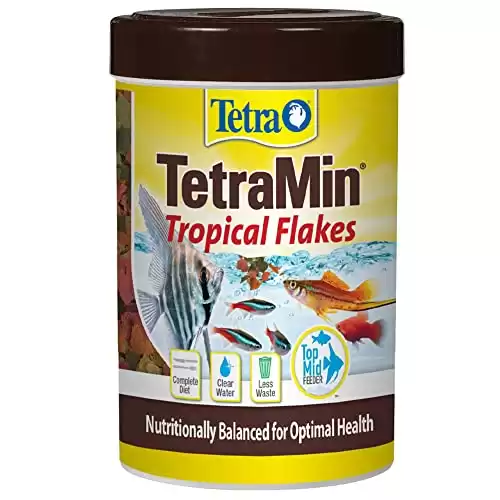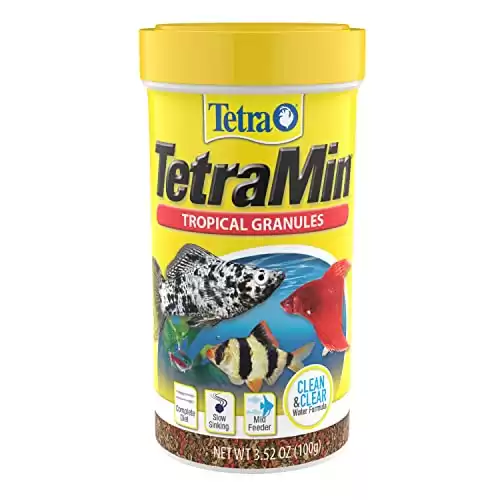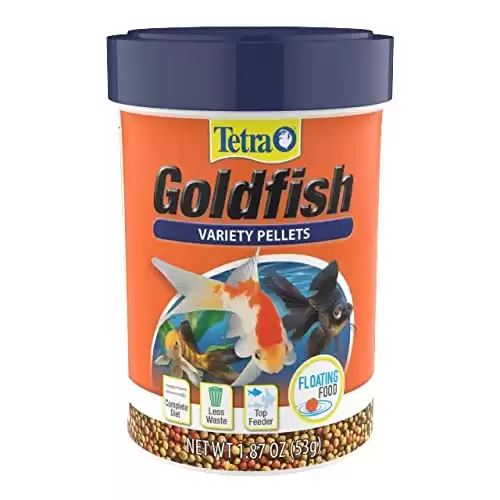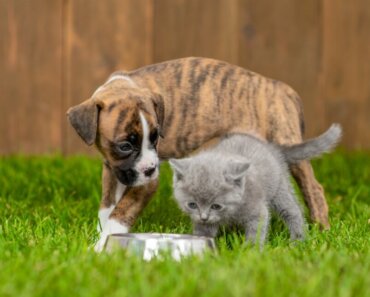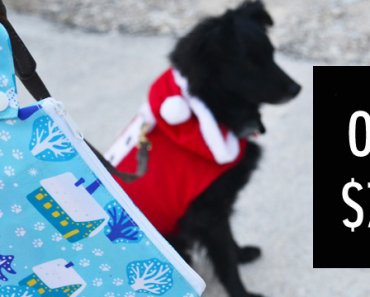If you’re keeping both goldfish and tropical fish, you might be wondering – can I skip buying two kinds of food for my fish, and just feed my goldfish the tropical fish food?
The answer is that tropical fish food is often not so different from goldfish food and can occasionally be used as a substitute.
What surprised me when researching this article is that many specialized goldfish foods also don’t appear to be very suitable as a long-term staple for goldfish!
Here I’ll explain why.
Firstly, What Are the Dietary Needs of Goldfish?
Goldfish are opportunistic omnivores.
In the wild, their ancestors the crucian carp would have eaten plants, algae, insects, and crustaceans. Pet goldfish kept in ponds are still lucky enough to feed on these things and are often healthier for it!
While these natural foods contain fairly high levels of fiber, fat, and medium levels of protein, they don’t contain many carbohydrates.
In an American study, scientists determined that the optimum nutritional content for goldfish is 29% protein, 13% lipids, and 9.7 calories of energy per gram of protein ratio.
The interesting thing is this is quite a long way off even the most specialized commercial goldfish foods on the market.
What Are the Dietary Needs of Tropical Fish?
Freshwater tropical fish are so numerous and diverse that asking this question is a bit like asking what are the dietary requirements of terrestrial mammals!
Although a horse or a cow might do very well eating grass and weeds, the same wouldn’t be true for your pet dog.
Having said that, most tropical fish are fairly omnivorous. While some families like plecos and hillstream loaches will eat mostly algae and plant material, others like betta fish and Oscars enjoy plenty of meat in their diet.
Generic tropical fish flakes tend to contain a range of ingredients to satisfy the feeding habits of most tropical fish, and usually contain a fairly high degree of protein (40% or more).
Comparing Tropical Fish Foods With Goldfish Foods
Looking at the nutritional contents of tropical and goldfish foods, I was surprised to find that some of them are fairly similar.
Here are some examples of the ingredients and nutritional values of some of the most popular tropical fish and goldfish flakes and pellets.
TetraMin Tropical Flakes vs TetraFin Plus Goldfish Flakes
TetraMin Tropical Flakes Ingredients and Nutritional Information
- TROPICAL FORMULATION: Highly digestible ingredients for use as staple food for your top- and mid-feeding tropical fish.
- COMPLETE DIET: Nutritionally balanced for optimal health.
- ACTIVE LIFE FORMULA: With added antioxidants for healthy cells, select proteins for growth and prebiotics for digestion.
- CLEAR-WATER FORMULA: Won’t cloud water when used as directed.
Main ingredients:
Fish meal, Dried Yeast, Ground Brown Rice, Shrimp meal, Dried fish protein digest, Wheat gluten, Oatmeal, Fish oil, Potato protein, Soybean oil, Dehulled soybean oil, Vitamin b12 supplement, Mixed Tocopherols, and added Vitamins and Mineral
- Protein: 46%
- Fat: 11%
- Fiber: 3%
- Carbohydrate: Not stated
TetraFin Plus Goldfish Flakes Ingredients and Nutritional Information
Main ingredients:
Fish Meal, Ground Brown Rice, Dried Yeast, Shrimp Meal, Feeding Oatmeal, Wheat Gluten, Fish Oil, Soybean Oil, Corn Gluten, Algae Meal, Sorbitol, Lecithin, Potato Protein, Yeast Extract, Ascorbic Acid, and added Vitamins and Minerals.
- Protein: 44%
- Fat: 12%
- Fiber: 3%
- Carbohydrate: Not stated
As you can see from the nutritional profile of these two products, there isn’t a lot of difference between them! The protein and fat contents only differ by 1-2%, and the fiber content for both flake foods is 3%.
As for ingredients, the top four ingredients for both products are the same: Fish Meal, Ground Brown Rice, Dried Yeast, and Shrimp Meal. The rest of the ingredients didn’t differ a lot either, although we don’t know the exact proportions.
What’s interesting is the presence of several sources of starchy carbohydrates in both types of food: Brown rice, oatmeal, wheat gluten, and corn gluten.
These types of terrestrial grains would rarely feature in the diets of tropical fish or goldfish, and excessive carbohydrates are not good for fish health.
Tetramin Granules vs Tetra Goldfish Variety Pellets
TetraMin Granules Ingredients and Nutrient Information
- TROPICAL FORMULATION: Highly digestible ingredients for use as staple food for your mid-feeding tropical fish.
- SLOW-SINKING GRANULES: Daily diet for small, juvenile or shy fish – great for bettas, too.
- NUTRITIONALLY BALANCED: Scientifically developed mix of highly nutritious ingredients that’s easily digested.
Main Ingredients:
Fish Meal, Dehulled Soybean Meal, Wheat Germ Meal, Feeding Oatmeal, Corn Gluten, Potato Protein, Dried Yeast, Shrimp Meal, Wheat Flour, Ground Brown Rice, Wheat Gluten, Fish Oil, Mono-Basic Calcium Phosphate, Dehydrated Alfalfa Meal, L-Lysine Monohydrochloride, Lecithin, Algae Meal, Soybean Oil, added Vitamins and Minerals.
- Protein 46%
- Fat 7%
- Fiber 2%
- Carbohydrate: Not stated
Tetra Goldfish Variety Pellets Ingredients and Nutrient Information
- GOLDFISH FORMULATION: Specially designed for use as a staple daily food for your goldfish
- COLORFUL, FLOATING PELLETS: Scientifically developed mix of highly nutritious ingredients plus vitamins, minerals and trace elements
- BITE SIZE: Nutritionally complete diet also enhances your goldfish’s naturally brilliant colors
Main Ingredients:
Wheat Germ Meal, Corn Flour, Feeding Oatmeal, Dehulled Soybean Meal, Wheat Gluten, Fish Meal, Wheat Flour, Wheat Starch, Dried Yeast, Potato Protein, Algae Meal, Dehydrated Alfalfa Meal, Corn Starch, Shrimp Meal, Monobasic Calcium Phosphate, Soybean Oil, Corn Gluten, Lecithin, Fish Oil, Yeast Extract, Ascorbic Acid, added Vitamins and Minerals.
- Protein 34%
- Fat 7 %
- Fiber 2%
- Carbohydrate: Not stated
Interestingly, the difference in nutrition between pellet foods for goldfish and tropical fish is far greater than in flakes.
Whereas tropical pellets have 46% protein, goldfish pellets only have 34%, which is closer to the 29% amount recommended in the study mentioned earlier.
But what is less reassuring is that the five main ingredients for goldfish pellets are based on wheat, corn, oats, and soya, before any natural aquatic ingredients are added at all.
Wheat, corn, and oats are carbohydrate-heavy grains that are unlike the leaves, algae, and animal-based foods that goldfish have evolved to consume in the wild.
Are Flakes or Pellets Better for Goldfish?
Comparing these products raises another interesting question. Since goldfish flakes and goldfish pellets from the example we analyzed have quite different ingredients and nutritional qualities, which one is best for my fish?
Pellets have the advantage of floating and remaining in one piece, while flakes can dissolve and contaminate the water.
But as far as nutritional qualities go, it’s a difficult question because although the pellets have a lower protein content that might be good for goldfish, they also seem to be very heavy in starchy carbohydrates.
Excessive carbohydrates in the diet are a major cause of diabetes, obesity, and liver damage in goldfish so I’m surprised at the manufacturer’s choice of ingredients.
My guess as to why flake food might be higher in protein is probably that flake foods are more suitable for baby goldfish that need more protein in their diet as they grow.
Pellets are suitable only for fish that are already over 2 inches in length and are large enough to consume them.
Since both products are simply marketed as ‘goldfish food’ it would be helpful if the manufacturers made the reasons for the difference in nutritional content clearer.
Better Foods for Goldfish Health & Nutrition
Having delved into the ingredients of popular goldfish foods, I have found them to be quite similar to tropical fish foods, seeming rather too high in grain-based protein and carbohydrates, while not having sufficient natural fats and fiber.
Although high-carb diets might be just as popular with goldfish as with humans, we all know that these can also lead to health problems in the long run.
When they’re happy, pet goldfish can live a staggeringly long time. The world record goes to Tish, who lived to be 43 years old with a family in the UK, and his owner attributed his old age to never being overfed.
Many pet goldfish could probably be living longer if they were given a good tank environment and a nourishing feeding regime.
Algae
Scientific studies have found that algae-based foods are well assimilated by goldfish. Goldfish fed on foods with a high algae content show higher glycogen and carotenoid levels, as well as brighter pigments in the fish.
If your fish food doesn’t contain much algae, you can include it in your goldfish’s diet by feeding them occasional algae wafers.
Meaty Foods
Also great for goldfish are natural live food, frozen food, or freeze-dried food like bloodworms, daphnia, brine shrimp, mosquito larvae, and tubifex worms that reflect some of the live prey that wild goldfish would consume as part of their natural diet.
Freeze-dried foods can be very handy but always soak them thoroughly before feeding to avoid stomach upsets.
Never feed your fish with the meat of birds and mammals as this type of protein is quite different from what a goldfish gut is designed to digest!
Plant-based Foods
Goldfish also like some plant matter in their diet, and, although they are notorious for destroying aquarium plants, this is partly because they make a useful part of their diet.
Elodea, Anacharis, Cabomba, Hornwort, Water lettuce, and Water hyacinth are all said to be good fodder for goldfish.
Even if that makes these plants difficult to grow in a goldfish tank, you could still offer them to your goldfish sometimes as a nutritional supplement.
Plants that goldfish might occasionally graze on but are less likely to destroy include Java fern, Java moss, Anubias, and Crypts. Goldfish can also be fed on terrestrial vegetables such as spinach, lettuce, and cooked garden peas.
Weighing It Up – The Best Foods for Goldfish
Tropical fish foods are definitely not a good idea to feed your goldfish as a staple food, but I’d argue that many of the commercial goldfish foods are also lacking the diversity and nutrient profile that goldfish need to remain healthy in the long run.
Better than feeding them purely dried foods is to offer your goldfish a broad-ranging menu, including high-quality dried foods, aquatic meaty foods, plant foods, and algae.
Always check the ingredients and nutrient information on your fish food to make sure it comes from high-quality sources and that it matches your fish’s needs.

